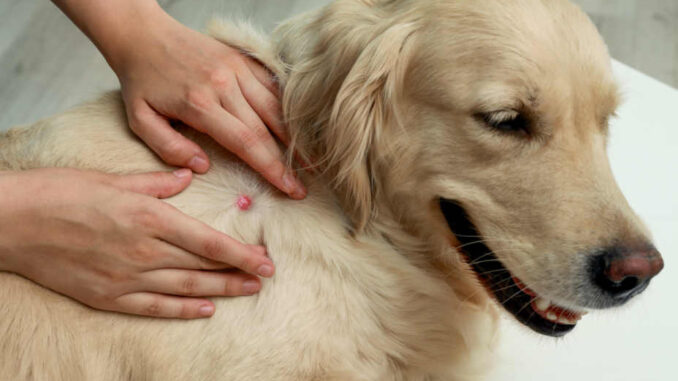
This article was updated on February 13th, 2024

Seeing a new red lump or bump on your dog can be scary. But don’t jump to conclusions just yet. Our veterinarians Dr. Chyrle Bonk and Dr. Jamie Whittenburg have treated hundreds of dogs with a red lump. In this article, they will provide important information you should know as well as 9 types of red lumps that are most commonly found on dogs (with images).
9 common types of red lumps in dogs (with images)
The most likely causes of red lumps and bumps in dogs are:
1. Histiocytomas
Histiocytes are cells that work surveillance for the immune system. Occasionally, especially in younger dogs, these cells can over-reproduce and create small, red lumps. These bumps are fast-growing but are benign.
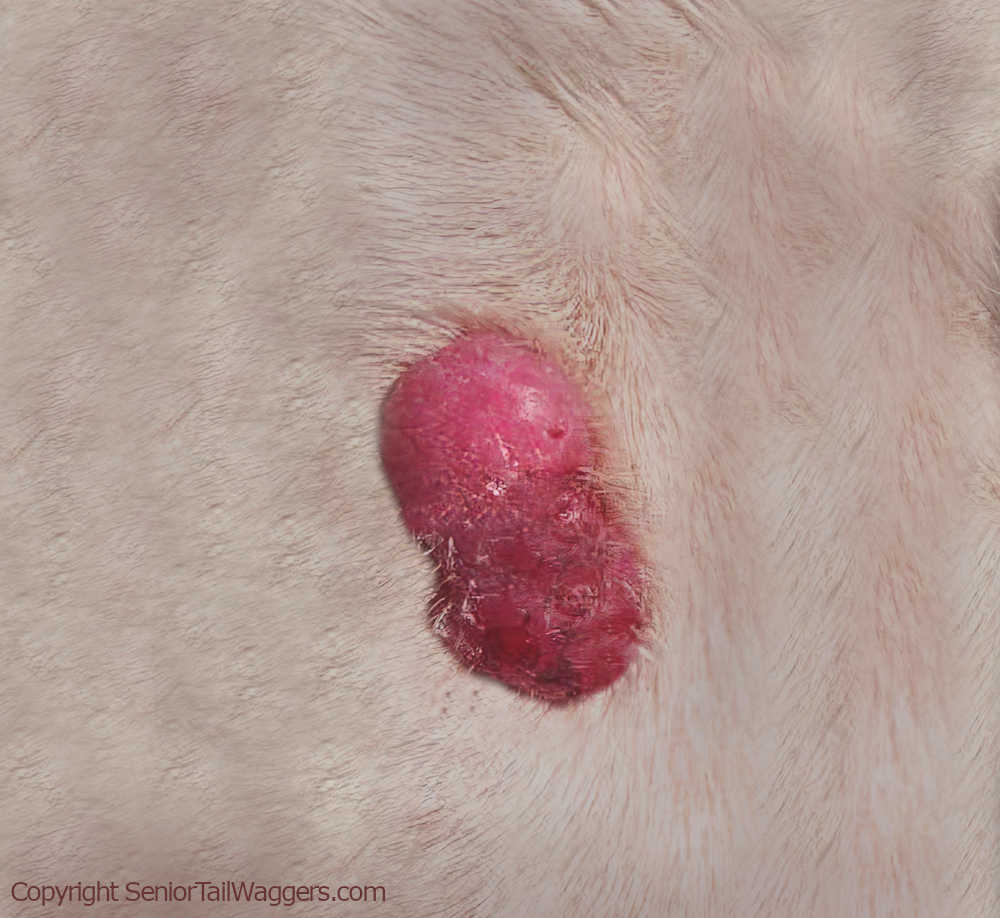
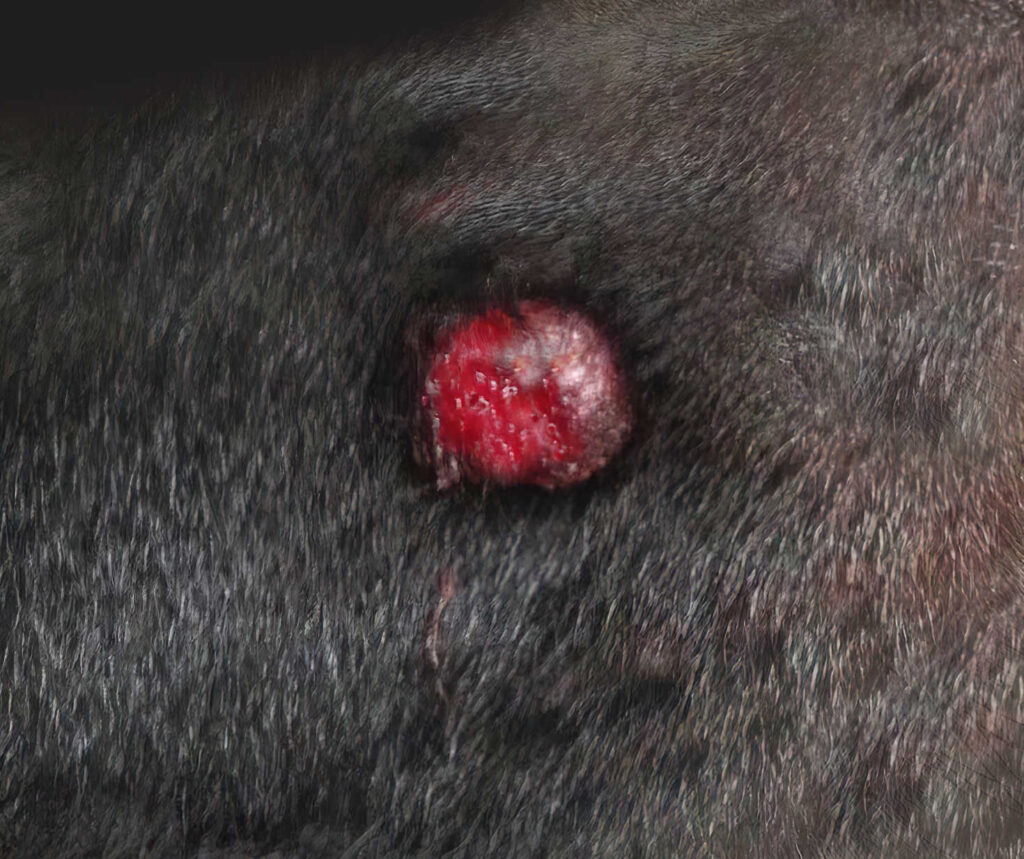
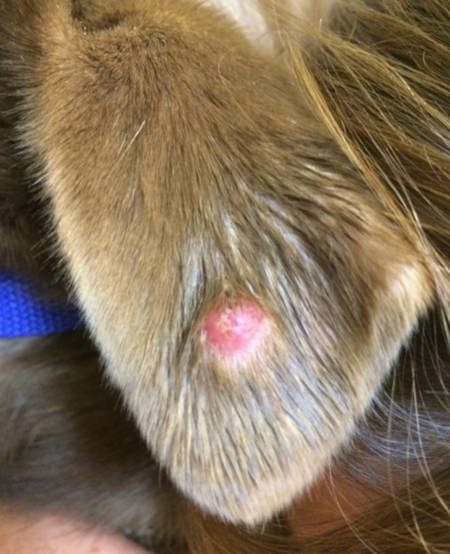
Treatment and prognosis: Histiocytomas often go away on their own, usually within a few months. However, if your dog is bothered by it or has caused ulceration or an infection, surgical removal may be necessary.
Learn more about Histiocytomas.
2. Warts
Warts are very frequent in dogs, especially senior dogs. They are caused by an infection with the papillomavirus. While warts are typically a darker color, they may also appear pink/reddish, as shown in the pictures below.
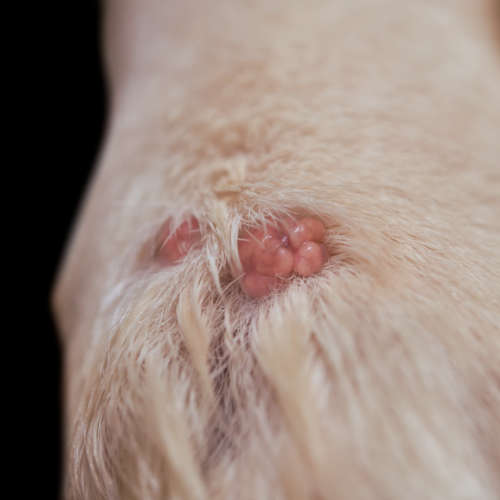
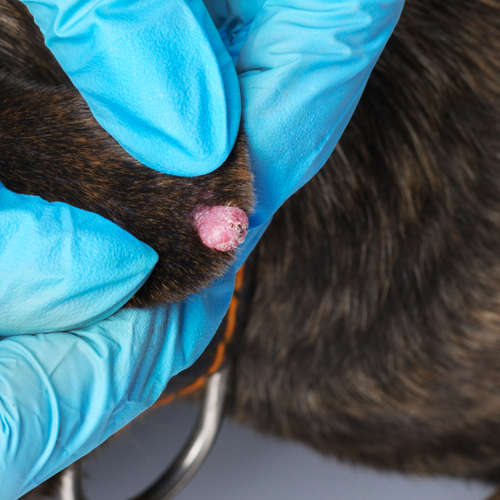
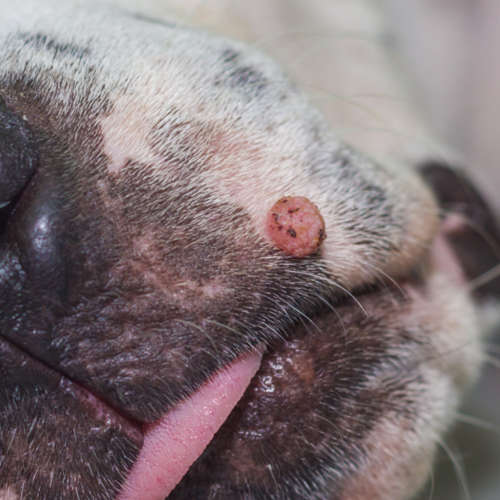
Treatment and prognosis: Warts are most often benign. Occasionally, they can become cancerous, so any wart that is a long-term issue or that changes in color/size/look needs to be investigated by a vet.
Learn more about Warts.
3. Skin tags
Skin tags are another benign growth in dogs that typically occurs as dogs get older. They are usually fairly small, soft, and the color of a dog’s skin. Occasionally, they can become red and inflamed if your dog scratches them, as shown below.
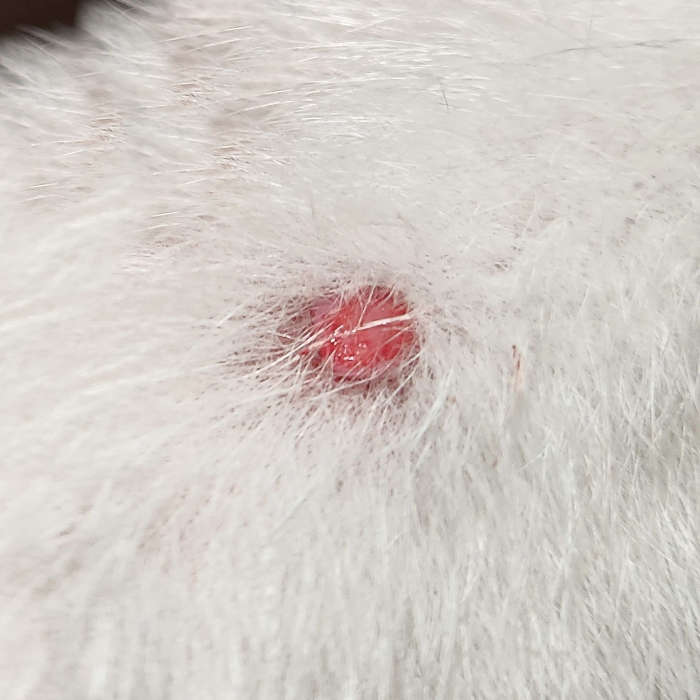
Most skin tags won’t require treatment and generally don’t get big enough to become problematic.
Learn more about Skin Tags.
4. Mast cell tumors
Mast cell tumors come in very different shapes and sizes—including red lumps or bumps, as pictured below.
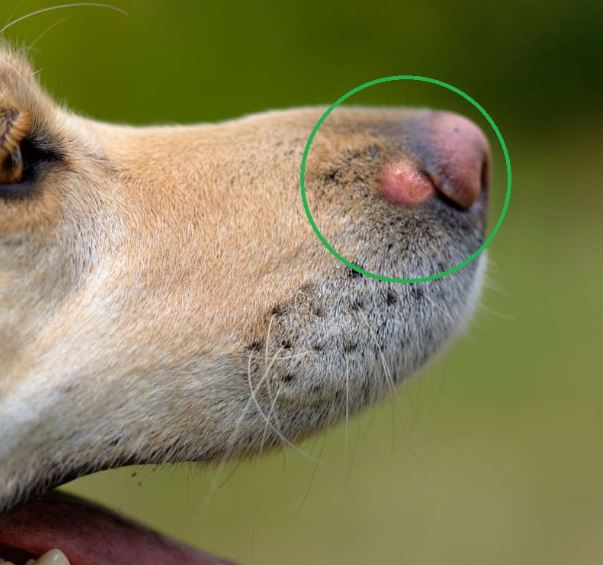
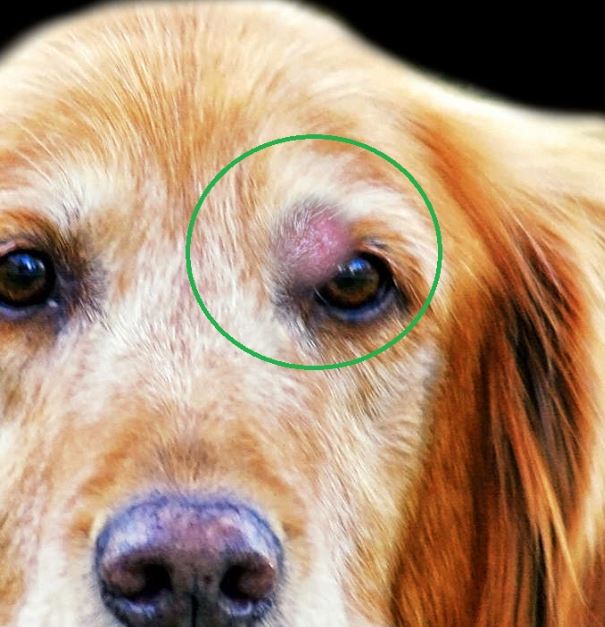
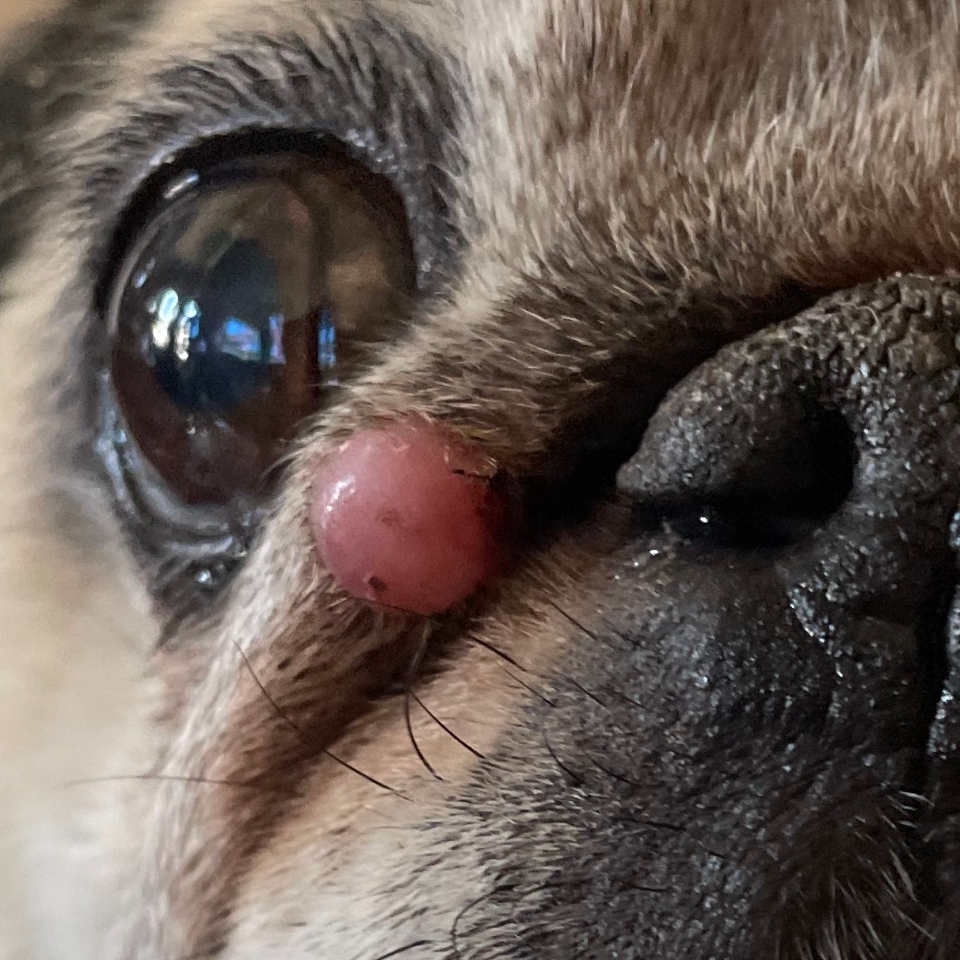
These tumors are more often seen in middle-aged and older dogs but can affect younger dogs, too. Mast cell tumors are not always malignant, but it’s impossible to know which ones are and which aren’t without a fine needle aspirate or biopsy.
Treatment and prognosis: If caught early on, mast cell tumors have a high success rate with removal. If caught later, these tumors may spread to local lymph nodes and other organs, requiring surgical removal as well as chemotherapy.
Learn more about Mast Cell Tumors.
5. Squamous cell carcinomas
Squamous cell carcinomas in dogs are fairly rare, and they vary in their levels of aggressive cancerous behavior in terms of spreading.
These types of malignant tumors are usually found on areas of skin that are bare or have little hair. They are more common in dogs with light-colored skin. Squamous cell tumors in dogs can be raised lumps or nodules, or flatter areas of ulcerated skin. They sometimes resemble warts. The growth pictured below is one example:
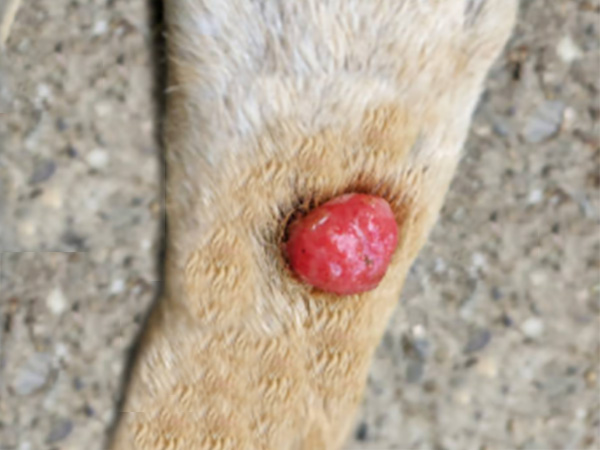
Treatment and prognosis: The most common treatment for squamous cell carcinomas is surgical removal.
Learn more about Squamous Cell Carcinomas.
6. Skin rashes and red bumps (allergies)
Dogs also develop bumps or rashes as a result of allergies or other irritants. This may appear as many small bumps or just a few larger bumps. The cause can be an allergy to fleas, pollens, or chemicals in the environment. Red bumps can also be a sign of mites. The bumps may also be itchy, which can cause bleeding, oozing, and secondary infections.
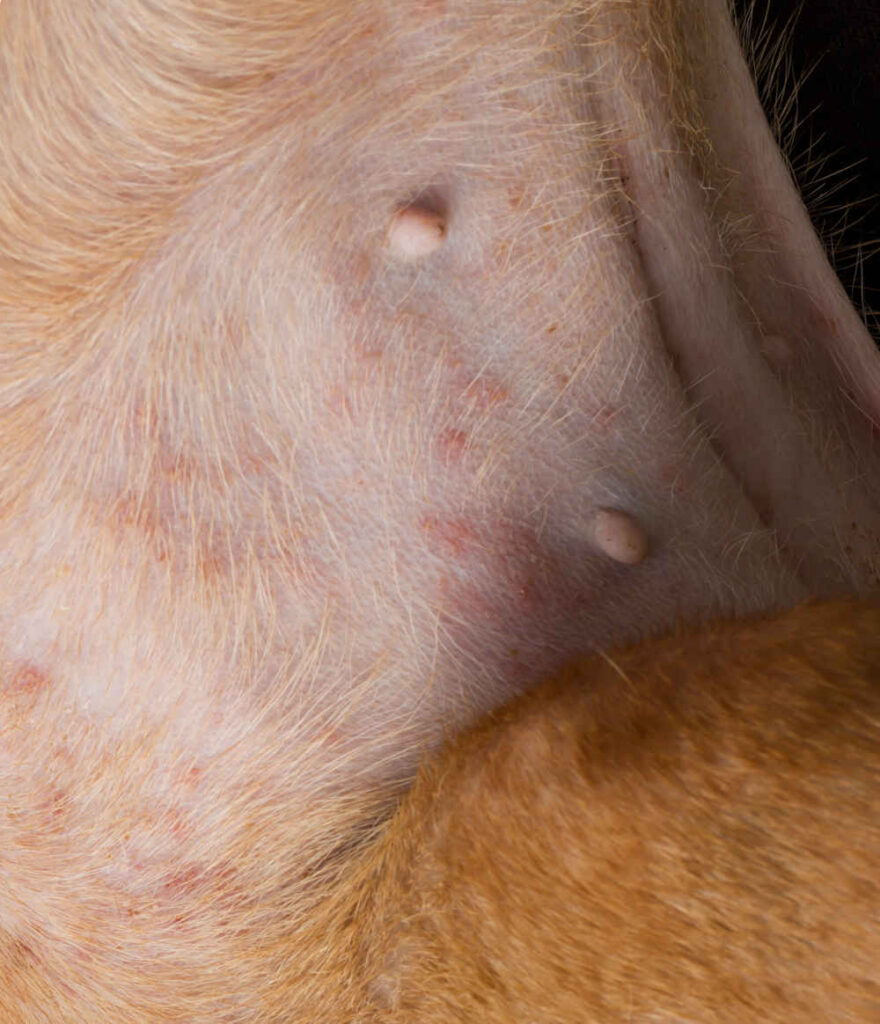
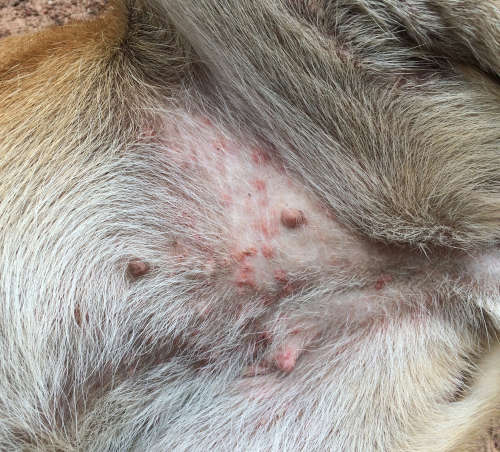
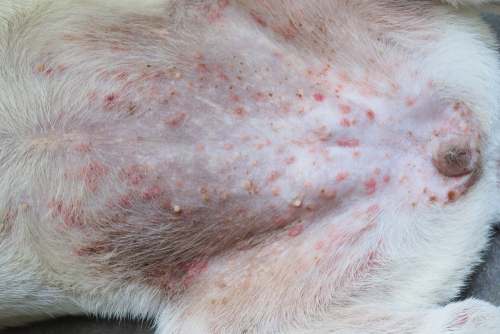
Treatment and prognosis: We treat most skin rashes in dogs by dealing with the underlying cause. For allergies, we start by trying to remove the allergen from the dog’s environment or treating with antihistamines or anti-inflammatories is usually helpful. When mites are present, we will treat the issues with an anti-parasiticide. Secondary infections may require antibiotics.
Learn more about Skin Allergy Rashes.
7. Foreign objects
Any dog that’s out and about may come in contact with things that are sharp and prickly. Sometimes, those things can become lodged in a dog’s skin, where they will become inflamed and develop a red bump. Grass seeds, thistle stickers, and slivers are common culprits. Dogs may lick at these bumps, causing them to become raw and ooze. They may grow very quickly and be quite alarming.
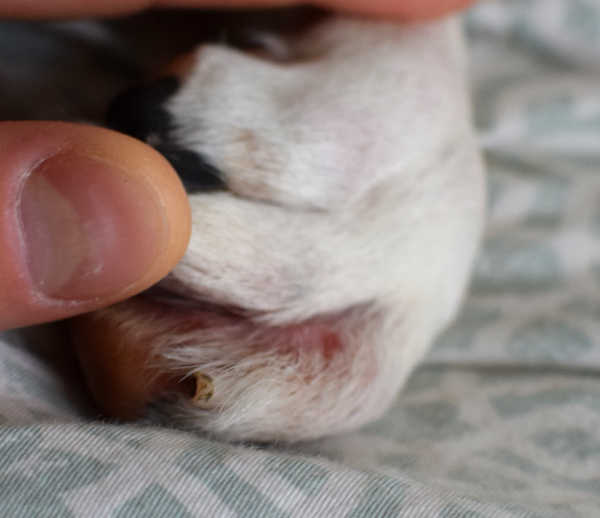
Treatment and prognosis: Veterinary treatment is usually recommended: leaving a foreign body can make it worse and increase the likelihood of complications. Surgical removal is usually all it takes. Sometimes, those objects can be too small to see. Soaking the area in Epsom salts and getting antibiotics from your veterinarian (to control secondary infections) can get rid of most foreign body issues. Learn more.
8. Cysts
Interdigital cysts, also known as interdigital furunculosis, are typically small, firm bumps between the toes, usually on the front feet (see picture below). They are usually red and inflamed, sometimes oozing discharge or pus.
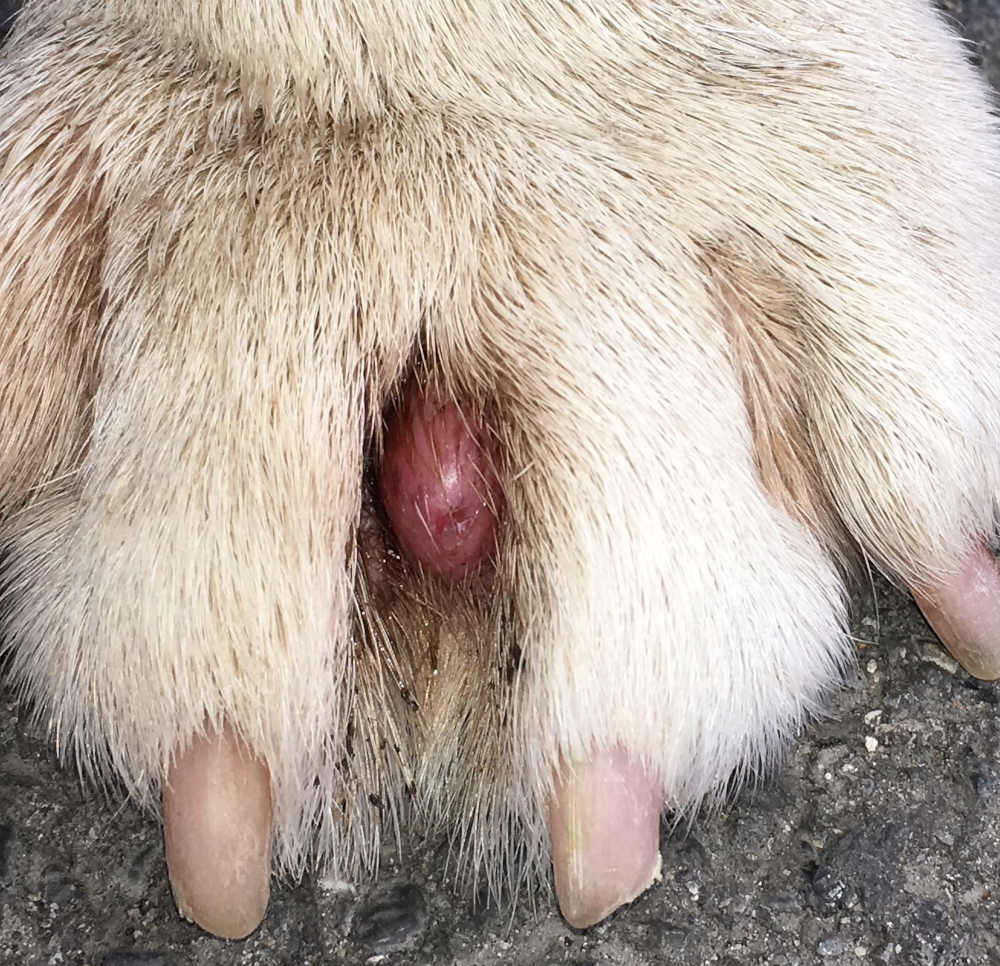
Treatment and prognosis: Home treatments include bathing with Epsom salts. However, this is unlikely to fully resolve the cyst, and veterinary treatment is recommended to address the underlying cause (for example, a foreign body or an allergy). Treatments may include antibiotics, bathing, anti-inflammatory medication, and management of any underlying allergies. Learn more about Interdigital Cysts.
Other types of cysts can also become infected and look like red bumps, as shown in the image below (pearly, red, and raised bump that has slightly bruised and ulcerated on the surface):
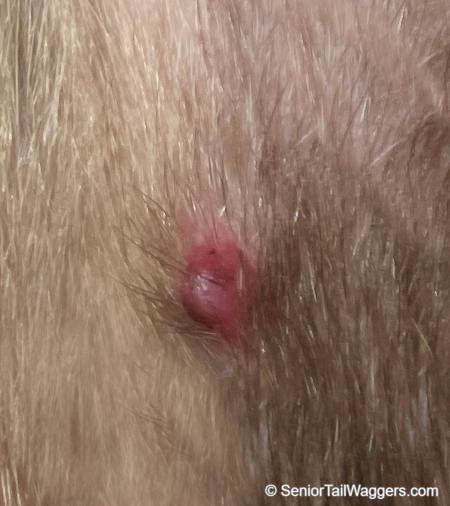
9. Melanomas
Melanoma tumors are dark and can be small, or large, flat, or raised. They can be either benign or malignant, so they shouldn’t be ignored. If a dog has malignant melanoma, it’s usually an aggressive cancer that recurs even after removal and may spread throughout the body quickly, so the lesion needs to be surgically removed as quickly as possible.
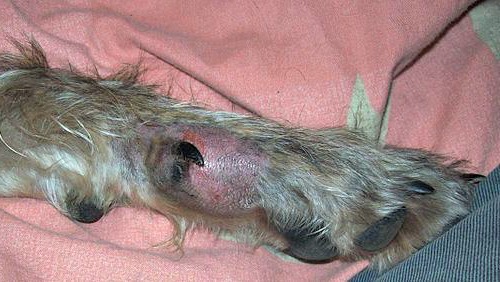

Treatment and prognosis: Malignant melanomas are very aggressive, and prompt treatment is required for the best outcome. Surgery is required to remove the initial tumor, and radiation may be necessary to deal with any spread. Chemotherapy generally isn’t very successful.
Read more about Melanomas.
Important: It is often not possible to diagnose a lump just by looking at it. Diagnosis often involves taking samples and analyzing them under a microscope or sending them to a laboratory for analysis. Learn more.
A red lump can be cancerous, but most are harmless
A raised red lump on a dog is usually the skin’s way of showing inflammation. It can be as benign as a wart or an irritated cyst. As Dr. Bonk clarifies, many are benign so it’s important not to jump to conclusions:
“As a veterinarian, I’ve seen many red bumps and lumps in dogs. Most are harmless, but some can be cancerous. Cancerous lumps are typically growing rapidly or changing in appearance quickly. Cancerous lumps are often firmer to the touch and tend to have more irregular shapes.”
On the other hand, a red color, as well as ulceration and a firm, irregular texture, are all common properties of a cancerous growth. The picture below shows a red cancerous growth:
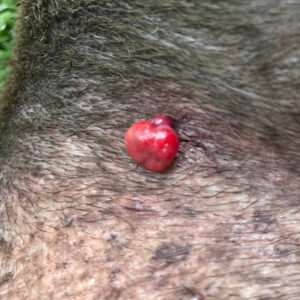
“Yes, red, black or just generally ‘unhealthy’ looking lesions are more likely to be cancerous. However, most red lumps are benign so it’s important to get your dog’s lump tested with a biopsy. Hopefully this will confirm good news.”
Should I take my dog to the vet?
When to call your veterinarian:
- The bump changes size, shape, or color. Taking pictures and measurements every couple of days can really help you get an idea of whether the lump is changing or not.
- The bump oozes, bleeds, or ruptures.
- Your dog constantly licks or chews on the bump.
- Your dog develops any new similar lumps.
- Your dog is showing other signs of illness.
When you can monitor the lump at home:
- The lump stays a uniform size, shape, and color.
- Your dog isn’t bothered by it.
- It appears to be getting smaller/better.
If you choose to monitor your dog’s lump at home, it still may be a good idea to get in touch with your vet just so that they know what’s going on if you end up bringing them in. Also, keep in mind that any changes in a lump, no matter how small, can be significant.
How is a new red bump diagnosed?
There is no surefire way to diagnose a lump with full confidence just by looking at it. It is important to get a biopsy done to know what you are up against. A biopsy is a medical procedure to extract and examine a small tissue sample. Our veterinarian director Dr. Whittenburg, explains:
“We have had red lumps that seemed benign come back as cancerous after lab analysis, and vice versa. The diagnosis of skin lumps and bumps often involves your vet taking samples and sending them to an external laboratory for analysis.”
Diagnostic tests typically cost $300-$500, but biopsies done under anesthetic may cost $600 or more. Learn more about biopsies to diagnose lumps.
Other less common causes
Hot spots, ulcers, and lick granulomas
Things like ulcers or erosions of the skin, a raised hot spot, or a lick granuloma can all take on the appearance of a red bump. They will usually be hairless, red, and could be bloody or moist.
Dogs often lick them, which usually makes them worse. Pictured below is a cancerous bump that has become ulcerated, most likely due to the dog licking or scratching it:
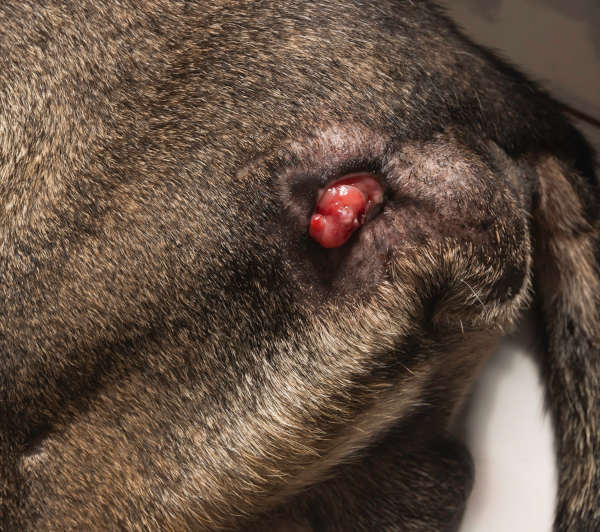
Causes:
- Hot spots are often due to allergies or excessive moisture trapped in a thick hair coat.
- Ulcers can be due to a wound or self-inflicted by the dog licking or scratching at a different kind of bump or lump.
- Lick granulomas are another self-inflicted issue where a dog excessively licks because of arthritis pain in a joint, allergies, or anxiety.
Treatment and prognosis: Ulcers, hot spots, and granulomas are best treated by treating the underlying condition. This often includes antibiotics, anti-inflammatories and creating some kind of roadblock to prevent licking. Lick granulomas may also require behavior modification or medication to treat.
Insect or bug bites
Bug bites or stings can potentially cause red bumps on your dog’s skin, especially if you’re dealing with an external parasite like fleas or mange. Below is a picture showing an insect bite on a dog’s lip.

Dogs may also be itchy with these types of bumps, and you may see other evidence, like flea dirt on their fur.
Treatment and prognosis: A veterinarian will be able to diagnose bug bites and treat them accordingly.
Related posts:
Red Skin Issues and Rashes in Dogs
Images of Skin Problems in Dogs
Common Lumps and Bumps on Dogs
Red Bumps or Spots on the Belly
Disclaimer: This website's content is not a substitute for veterinary care. Always consult with your veterinarian for healthcare decisions. Read More.


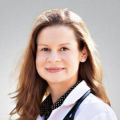
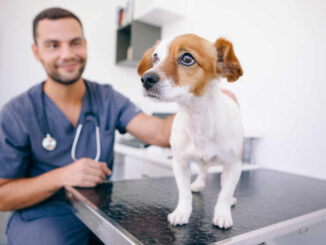
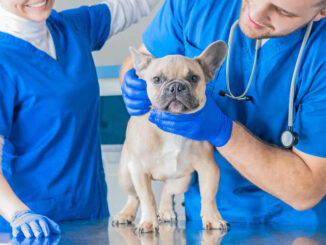

There’s no way I could afford to get my dog a biopsy. He is my world. Only 11 months old but has a firm bloody filled looking bump on his tummy. It’s pea size and itchy. I tried to poke it in case a tick was imbedded. But it isn’t a tick. So I alcoholed the area and am keeping an eye on it. Is there anything else I can do for him? Also it’s a singular bump very red no nodules. Please help. And thank you for all the wonderful information.
Hey Tia, I’m sorry to hear about your predicament. At his age, some of the more common causes here would include a papilloma (wart) histiocytoma or haemangioma; all of which are benign growths. I agree we should keep it clean and I’d use salt water and cotton wool to bathe it daily. If not resolving or if growing, I would try and get it checked by his local vet. Dr Linda Simon MBV MRCVS
“The information on this website is not a substitute for in-person veterinary care. Always seek advice from your veterinarian if you have concerns about your pet’s medical condition.”
My dog has a lump on his head size of a pea it’s pink and loke a bubble he’s a 11 yr old siberian husky
I’m sorry to hear about this Angie. These sort of lumps can be a range of things, including a wart, cyst, skin tag or a tumor. As he is an older dog, we’d want to have the lesion examined and possible biopsied, in case it could be a cancer. If it is, the sooner we remove it, the better the prognosis. Dr Linda Simon MVB MRCVS
“The information on this website is not a substitute for in-person veterinary care. Always seek advice from your veterinarian if you have concerns about your pet’s medical condition.”
Honestly, I would just have him get a check -up…so you can know for sure what it is..
They should be willing to bill you monthly..
You can go from there… BEST of luck…
Take care ❤️!